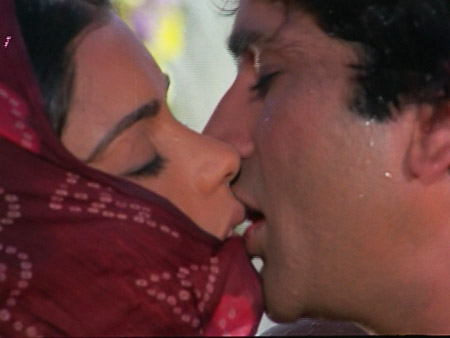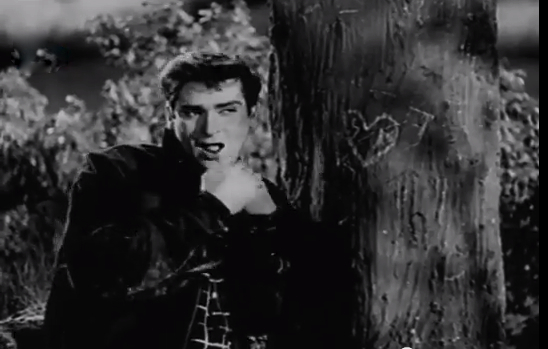
Rajesh Khanna and Sharmila Tagore clasp hands against the beautiful Darjeeling countryside in the film Aradhana (1969).
Today we present the lyrics and English translation of one of Bollywood’s favorite love duets “Kora Kaagaz Tha” from Aradhana (1969). The song is a welcome introduction to Autumn, filmed on location on the hilltops of Darjeeling where the only thing cozier than a view of the snow-capped mountains in the distance is Rajesh Khanna in a red turtleneck.
Aradhana has rightfully earned widespread acclaim as a monumental Bollywood masala flick that really epitomizes India’s Golden Age of filmmaking. Songs like “Kora Kaagaz Tha” remind us how romance could once be spun from the magic in the air rather than from the dwindling lengths of the heroine’s skirt or from 6,000,000 back-up dancers bumping to an added techno beat. Very few love duets get everything right like this one does, immersing their audience in the beauty of India’s natural landscapes while allowing the Urdu and music to speak for themselves. Sharmila Tagore with her dimpled smile and Rajesh Khanna winking his legendary wink are pure, no-added-hormones or preservatives-required bliss.
I can think of a few other songs that defrost my lifeless heart similarly: “Deewana Hua Badal” from Kashmir Ki Kali (1964) and “Abhi Na Jao Chhod” from Hum Dono (1961) come to mind.

Sharmila Tagore’s spotlight-hogging wig takes no prisoners in Aradhana (1969).
Film director Shakti Samanta famously recalled that after pitching the brief summary of Aradhana to lyricist Anand Bakshi, Bakshi was inspired to write the lyrics to “Kora Kaagaz Tha” within seconds. Who would’ve guessed almost 50 years later, those same poetic ideas would be resurrected in mainstream American pop music with Taylor Swift’s popular “Blank Space“? (OK, maybe T. Swizzle has never seen Aradhana before…but I bet if she did, her eyeliner would drip onto the floor from happy tears.)
The best advice I can give you is to put on your best plaid flannel, wrap a wool throw around you and the one you love, and take a long sip of apple cider before starting this one. I have your back, trust me. As you listen, soak in the full glory of the Urdu “ghain” that punctuates Kishore Kumar’s “kaaghaz” or the blissful pop of the Urdu “qaaf,” adorning Lata Mangeshkar’s “mulaaqaat.” These are elegant linguistic subtleties that are fast disappearing from Bollywood music today. Lyrics and English translation to “Kora Kaagaz Tha” are below!
Kora Kaagaz Tha Lyrics & English Translation:
KISHORE: Hey hey (hey hey) aahaa hmm hmm (hmm hmm) aahaa haa (haa) haa haa (hmm hmm)
Koraa kaaghaz thaa yeh man meraa (meraa meraa)
My mind was a blank sheet of paper
Likh liiyaa naam is pe teraa (teraa teraa)
Until I wrote your name upon it
Koraa kaaghaz thaa yeh man meraa
My mind was a blank sheet of paper
Likh liiyaa naam is pe teraa
Until I wrote your name upon it
LATA: Suunaa aa.Ngan thaa jiivan meraa
My life was a lonely courtyard
Bas gayaa pyaar is mei.N teraa
Until your love resided within it
KISHORE: TuuT na jaaye sapne mai.N Dartaa huu.N
I am afraid that my dreams may shatter
Nis din sapno.N mei.N dekhaa kartaa huu.N
I keep seeing you in my dreams all day and night
Nainaa kajraa re, matvaale yeh ishaare
Oh, those kaajal-lined eyes, those intoxicating signals
Khaalii Darpan thaa yeh man meraa
My mind was an empty mirror
Rach gayaa ruup is mei.N teraa
Until your beauty manifested within it
LATA: Koraa kaaghaz thaa yeh man meraa
My soul was a blank sheet of paper
Likh liiyaa naam is pe teraa
Until I wrote your name upon it
LATA: Chain ga.Nvaayaa mai.N ne, ni.Ndiiyaa ga.Nvaayii
I lost all peace of mind, I lost sleep
SaaDii saaDii raat jaaguu.N, duu.N mai.N duhaayii
I remain awake all night long and I pray
Kahuu.N kyaa mai.N aage? Nehaa laage, jee na laage
What should I say next? I have fallen in love, my soul is restless
Koii dushman thaa yeh man meraa
My soul was an enemy
Ban gayaa miit jaa ke teraa
Until it became your beloved
KISHORE: Koraa kaaghaz thaa yeh man meraa
My soul was a blank sheet of paper
Likh liiyaa naam is pe teraa
Until I wrote your name upon it
KISHORE: Baagho.N mei.N phuulo.N ke khilne se pehle
Before the flowers bloomed in the gardens
LATA: Tere mere naino.N ke milane se pehle
Before your and my eyes met
KISHORE: Kahaa.N thii yeh baate.N?
Where were words like these?
LATA: mulaaqaate.N?
Meetings like these?
KISHORE: aisii raate.N?
Night like these?
LATA: TuuTaa taaraa thaa yeh man meraa
My soul was a shooting star
KISHORE: Ban gayaa chaa.Nd hoke tera
It turned into a moon when I became yours
BOTH: Koraa kaaghaz thaa yeh man meraa
My soul was a blank sheet of paper
Likh liiyaa naam is pe teraa
Until I wrote your name upon it
LATA: Aa aa aaa aa
KISHORE: Aaa aa aaa
LATA: O hooo hoo hoo
KISHORE: O hooo hoo hoo
LATA: Hmm hmm mmm mmm
KISHORE: Hmm hmm mmm mmm
Glossary:
koraa: blank; kaaghaz: piece of paper; man: mind; likhnaa: to write; naam: name; suunaa: lonely, empty; aa.Ngan: courtyard; jiivan: life; basnaa: to reside, to settle; pyaar: love; TuuTnaa: to break; sapnaa: dream; Darnaa: to be afraid; nis-din: day and night; nainaa: eyes, kajraa: black eye-liner, re: an expression of emphasis, such as “oh!”; matvaalaa: intoxicated; ishaaraa: signal; khaalii: empty, Darpan: mirror; rachnaa: to create, to manifest; ruup: beauty; chain: peace of mind; ga.Nvaanaa: to waste, to ruin; ni.Ndiiyaa: sleep; saaDii: entire, whole; jaagnaa: to awaken; duhaaii denaa: to pray, to request; aage: next, future; nehaa: love; dushman: enemy; miit: loved one; baagh: garden; phuul: flower; khilnaa: to blossom; milnaa: to meet; baat: words; mulaaqaat: meeting; TuuTaa taaraa: shooting star; chaa.Nd: moon

Why, hello, cozy red turtleneck. Rajesh Khanna (of perfect human being fame) induces a sense of lightheadedness that the mountain’s altitude could never achieve alone.
Aradhana takes a turn for the spicy a few scenes later with Kishore Kumar’s solo “Roop Tera Mastana” because, after all, you can’t make a masala film without the masala. But those who would forever rather stick to the old fashioned tree-frolicks of classic Bollywood, stay here in safe territory with me as long as the season lasts.
– Mrs. 55












